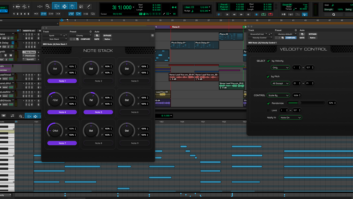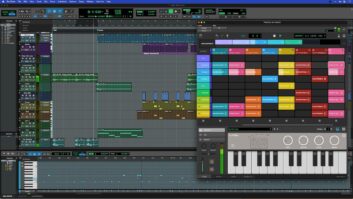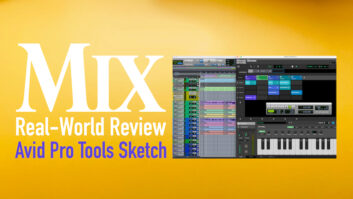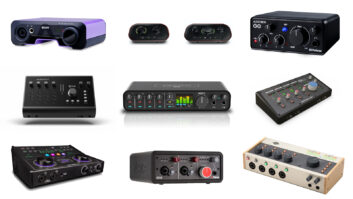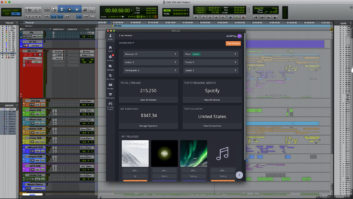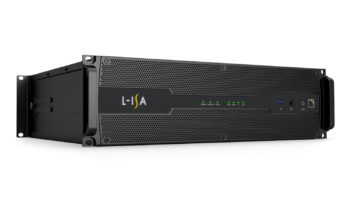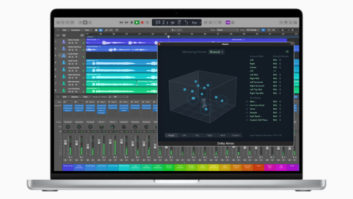In less than a year, the Apple iPad has morphed from the toy we didn’t need to the tool we can’t live without. Here, PAR’s senior contributor details his favorite iPad apps and tools, all useful for the audio professional.
After attending the 2011 Winter NAMM show, I’m convinced that anyone previously skeptical of the iPad’s validity as a legit audio tool would be crazy not to have a change of heart.
Less than a year after its initial release, the market has been flooded with a host of apps and accessories that practically make the iPad appear to have been designed specifically for the music industry. If the second version of the iPad hasn’t already been announced by the time you read this, chances are it is right around the corner and it will, no doubt, be even better suited for the music industry.
I’ve been wading through iPad apps and accessories since purchasing my iPad last summer. While there are literally hundreds of options out there, these are the ones I consider the cream of the crop.
The Apps
I’ve fallen for two recording apps, Sonoma Wire Works’ StudioTrack and Sound Trends studio.HD.
The Sonoma Wire Works’ FourTrack iPhone app has already been a favorite of iPhone and iPod touch recordists, so it is no surprise that the StudioTrack app is among the top of the iPad crop. The $39.99 app is the closest I’ve encountered to real-world recording, and it’s the only recording or programming app covered in this article that is so intuitive that I was able to fully utilize it without even briefly consulting a manual.
StudioTrack provides up to eight tracks of audio on a multi-touch mixer that includes faders, knobs and metering. Like an analog console, StudioTrack allows multiple parameters to be simultaneously controlled and the channel order can be easily rearranged making it easy to stay organized. The metronome beats (which can optionally be used in the mix) are courtesy of the Discrete Drums multitrack drum library and support 3/4, 4/4, 6/8 and X/4 time signatures. The tempo can be entered numerically or via a tap function.
Once all eight tracks have been filled, the tracks can be bounced to a new song allowing the song to exceed eight tracks. This can be done an unlimited number of times and after the recording is complete, the WiFiSync option allows all of the original un-bounced tracks to be exported into a computer to be mixed.
Every StudioTrack channel includes a configurable effect rack. Configuration options include tempo-synchronized double delay, 4-band parametric EQ with Hi-Shelf, Hi-Peak, Lo-Peak and Lo-Shelf filters, one-band peaking parametric EQ and compressor. In addition to an effect send on each channel and a fully configurable reverb, the app includes a 4-band parametric EQ and a stereo-linked master compressor strapped across the stereo bus.
Sound Trends $9.99 studio.HD app provides eight multilayered audio tracks providing up to 24 total tracks of playback. Studio.HD is more complex than StudioTrack and will require a slight learning curve, but Sound Trends has some excellent YouTube videos that make learning the app a breeze. While StudioTrack lends itself more to organic recording, studio.HD is perfect for more pop/hiphop-oriented production including loops, remixing, etc. The app includes 900 loops: Loop sets are logically grouped into instrument parts (drums, bass, keys, guitars, etc.) that work well together. Loops can easily be auditioned at the current project’s tempo. Comping is possible, and editing is quick and easy as all operations intelligently snap to either the bar or the beat depending on the Zoom level.
While StudioTrack supports easy export into a full-featured DAW, studio.HD supports fully automated mixing with volume, panning and 13 effects making it possible to complete a complex mix entirely within your iPad. Every track includes volume control and up to four real-time effects (including High and Low Pass Filters, Gate, Stutter Loop, Stutter Stepped, Stutter Gate, Bitcrusher, Flanger, Glitchy Repeater, Delay), Pan and Reverb. Mixes are exported as a 16-bit/44.1 kHz AIFF files.
The $14 BeepStreet iSequence app is to sequencing what studio. HD is to recording. And like studio.HD, it is somewhat sophisticated making the online tutorial videos a necessity. The app is built around an 8-track sequencer that includes 165 built-in instruments (with more available). The 8-channel mixer includes five configurable effect slots with the option of adding Filtering, Reverb, Flange, Delay, Lo-Fi Crusher, Equalization or Compression. Instruments, tracks and views can be switched without stopping playback, making it possible to compose, play and mix simultaneously. The app supports HSQ, MIDI, WAV export and HSQ import.
There are two killer beat creation apps that re-create classic hardware devices, Propellerhead Software’s ReBirth for iPad and Korg’s iElectribe.
Propellerhead Software released ReBirth back in 1997, and it was a hit. Built into an easy-to-use package, the program recreated the classic sound of the Roland TR-808 and TR-909 drum machines and the TB-303 Bass synth. Propellerhead Software has resurrected this classic program as the $14.99 ReBirth for iPad app, which combines these three classic sounds with effects, pattern sequencers and a fantastic interface. ReBirth users will be able to use this app immediately as it is almost identical to the original. Completed songs can be shared via URL, Facebook or e-mail as a RBS (ReBirth Song) file or MP3.
Though not as old as ReBirth, Korg’s Electribe•R has been a mainstay in the electronic and dance music for going on 10 years now. Korg has transformed the Electribe•R’s entire sound engine and sequencer into an iPad app with the release of its $19.99 iElectribe iPad app.
The iElectribe’s step-sequencer is intuitive and easy to use as it recreates the feeling of drum programming on a hardware machine. Like the hardware Electribe, iElectribe provides a 4-part percussion synthesizer and a 4-part PCM synthesizer. iElectribe patterns and performances can be transferred into a MAC or PC via iTunes, using CD-quality wav files ultimately allowing them to be used in a computer or iPad-based DAW.
Wizdom Music’s $9.99 MorphWiz is the most expressive and enjoyable iPad instrument that I’ve encountered. Like a Theremin, it won’t necessarily work on every track, but it’s always fun to try. MorphWiz is the brainchild of Dream Theater’s Jordan Rudess, and it is a blast to play. Receiving its inspiration from Lippold Haken’s Continuum controller, MorphWiz lays out the notes of a preset or user-definable scale across the screen as vertical lines from low to high. Depending on how you drag your finger across the screen, sounds can morph from one sonic character to another. The app’s built-in recording function allows a single performance or several layers of performance to be exported as an audio file. The results can be exported, e-mailed or sent to apps that support AudioPaste.
My favorite iPad app is Neyrinck’s $49.99 V-Control Pro that transforms the iPad into a full-featured, multi-touch control surface for Pro Tools. The app supports Pro Tools 7 and later on Intel Macs (PC support is coming soon) and uses the HUI control surface protocol via WiFi to control transport, editing, and mixing functions as well as advanced control of sends, automation, groups, auditioning, plug-ins, scrub/shuttle, I/O assignment and tons more within an easy-to-use interface.
V-Control pro utilizes the free Ney-Fi utility that must be installed and run on the computer that is running Pro Tools. By creating a virtual software MIDI port, Ney-Fi allows Pro Tools to communicate with V-Control over a network.
If you don’t already use Dropbox, it’s a necessity if you are an iPad user. Actually, it’s a necessity, period. The basic account, which includes 2 GB space, is free while Pro 50 (50 GB space) or Pro 100 (100 GB space) accounts are $9.99 or $19.99/month.
I became aware of Dropbox just over a year ago when many of my video clients began requesting it as the preferred method of delivering mixed audio for their projects. In addition to being a great way to send and receive files to and from your clients, backup your data and share photos, it provides an easy way to transfer audio information between your iPad and the rest of the world. Free iPad and iPhone apps provide easy access to your cloud data from virtually anywhere making it easy to share a project’s audio files or reference a mix or overdub anywhere.
Besides using the iPad to manipulate audio, program beats and create music, I’m routinely creating and editing Word 97-2010 (.doc and .docx) compatible documents and Excel 97-2003 (.xls) compatible spreadsheets using the Byte Office HD ($7.99) app along with the Apple Bluetooth Wireless Keyboard which allows lightning fast typing and data entry in comparison to the convenient yet extremely slow onscreen keyboard. Dropbox allows these files to easily be traded back and forth between my iPad, iPhone and laptop for continual editing and entry.
Hardware
The $229 Future Sonics Atrio Special Edition in-ear monitors are single-driver monitors perfectly suited to work with the iPad. The Atrio’s MG7 proprietary dynamic drivers have an 18 Hz – 20 kHz frequency response and provide a more full, natural sound at volumes lower than other transducers. Included with the monitors are a large variety of silicone and foam sleeves insuring ultimate comfort and fit. In addition to physically providing up to 26 dB of ambient noise rejection, the Atrio, unlike 2-, 3- and 4-way earphones, have no electronic or comb filtering artifacts, no phase issues and no crossover dropouts. I’ve experimented with several different in-ear monitors (none with custom molds as of yet) and the Atrio lead the pack in detail, depth and low-frequency accuracy. Environmentally conscious engineers (which is hopefully everyone reading this) will be happy to learn that the earphones include eco-friendly packaging (including a case made with reclaimed-rubber from old truck tires).
I’ve found the $89.95 Boa push iPad messenger bag to be the perfect way to lug my iPad around in style. The bag is crafted from durable Twylon and Nappa leather and is equipped with a wide, comfortable seatbelt nylon shoulder strap and a sturdy snap-button flap closure. I’ve been carrying it for nearly six months now, and it gets as many comments as the iPad itself. In addition to carrying my iPad and keeping it safe, the bag comfortably holds my Future Sonics Atrio Earphones, iPhone, credit cards and drivers license.
Besides being a great bag, one of the things that I love about the Boa push and the rest of the booq bags is that they include Terralinq registration. This means that if you lose your bag and an honest person finds it, Terralinq will reference the bag’s unique number (which you register on line after you purchase the bag) and will then contact you with the bag’s location and the finder’s contact information, allowing it to be safely retrieved.
While the iPad’s built-in audio output is reasonably good, it’s far from audiophile-quality, and its built-in mic leaves much to be desired. There is a wonderful-sounding workaround though. I picked up the $29 iPad Camera Connection Kit that adds connectivity with some (it seems to be hit and miss as to which ones) USB audio interfaces. I used this method to connect the iPad to a Benchmark DAC1 USB D/A interface and was amazed at the sound quality I was able to achieve through a pair of Dynaudio BM-5A monitors. The Benchmark has a wonderful built-in, headphone amp which, coupled with the Future Sonics Atrio earphones, also yields a fantastic listening experience.
I was also able to use the Apogee ONE interface (look for my full review next month) with the Camera Connection Kit while working with StudioTrack and studio.HD. Unfortunately, the iPad doesn’t provide enough juice to power the ONE, so I had to insert a powered USB hub into the chain to provide power to the ONE.
One of the coolest iPad accessories I saw at NAMM was the Alesis StudioDock. At approximately $199 street, this universal iPad docking station provides two inputs, via XLR/quarter-inch dual input connectors, with switchable phantom power and independently controllable gain. MIDI jacks allow external keyboard control, sequence recording or the ability to easily use the iPad as a sound module in the studio or for a live performance. Two quarter-inch outputs allow a pair of monitors to be connected to the dock, and a quarter-inch headphone jack provides headphone output (both have independent level controls). Direct monitoring is built-in to the headphone section making input monitoring possible with apps (like Tascam’s Portastudio) that don’t include input monitoring.
Summary
While the iPad in no way replaces a full-blown desktop or laptop computer when it comes to music creation, it does provide a long list of powerful recording and music creation tools that easily adapt into a professional’s workflow. Frankly, I can’t imagine how I lived without it.
Russ Long is a Nashville-based producer, engineer and mixer as well as a senior contributor to PAR.
